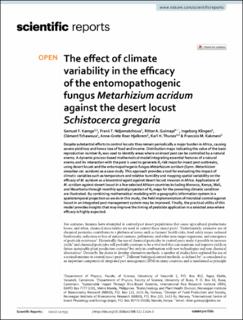| dc.contributor.author | Kamga, Samuel F. | |
| dc.contributor.author | Ndjomatchoua, Frank T. | |
| dc.contributor.author | Guimapi, Ritter A. | |
| dc.contributor.author | Klingen, Ingeborg | |
| dc.contributor.author | Tchawoua, Clément | |
| dc.contributor.author | Hjelkrem, Anne-Grete Roer | |
| dc.contributor.author | Thunes, Karl H | |
| dc.contributor.author | Kakmeni, Francois M. | |
| dc.date.accessioned | 2022-07-22T10:25:43Z | |
| dc.date.available | 2022-07-22T10:25:43Z | |
| dc.date.created | 2022-06-07T19:05:22Z | |
| dc.date.issued | 2022-05-09 | |
| dc.identifier.citation | Scientific Reports. 2022, 12 1-15. | en_US |
| dc.identifier.issn | 2045-2322 | |
| dc.identifier.uri | https://hdl.handle.net/11250/3007780 | |
| dc.description.abstract | Despite substantial efforts to control locusts they remain periodically a major burden in Africa, causing severe yield loss and hence loss of food and income. Distribution maps indicating the value of the basic reproduction number R0 was used to identify areas where an insect pest can be controlled by a natural enemy. A dynamic process-based mathematical model integrating essential features of a natural enemy and its interaction with the pest is used to generate R0 risk maps for insect pest outbreaks, using desert locust and the entomopathogenic fungus Metarhizium acridum (Synn. Metarhizium anisoliae var. acridum) as a case study. This approach provides a tool for evaluating the impact of climatic variables such as temperature and relative humidity and mapping spatial variability on the efficacy of M. acridum as a biocontrol agent against desert locust invasion in Africa. Applications of M. acridum against desert locust in a few selected African countries including Morocco, Kenya, Mali, and Mauritania through monthly spatial projection of R0 maps for the prevailing climatic condition are illustrated. By combining mathematical modeling with a geographic information system in a spatiotemporal projection as we do in this study, the field implementation of microbial control against locust in an integrated pest management system may be improved. Finally, the practical utility of this model provides insights that may improve the timing of pesticide application in a selected area where efficacy is highly expected. | en_US |
| dc.description.abstract | The effect of climate variability in the efficacy of the entomopathogenic fungus Metarhizium acridum against the desert locust Schistocerca gregaria | en_US |
| dc.language.iso | eng | en_US |
| dc.publisher | Springer Nature | en_US |
| dc.rights | Navngivelse 4.0 Internasjonal | * |
| dc.rights.uri | http://creativecommons.org/licenses/by/4.0/deed.no | * |
| dc.title | The effect of climate variability in the efficacy of the entomopathogenic fungus Metarhizium acridum against the desert locust Schistocerca gregaria | en_US |
| dc.title.alternative | The effect of climate variability in the efficacy of the entomopathogenic fungus Metarhizium acridum against the desert locust Schistocerca gregaria | en_US |
| dc.type | Peer reviewed | en_US |
| dc.type | Journal article | en_US |
| dc.description.version | publishedVersion | en_US |
| dc.rights.holder | © The Author(s) 2022 | en_US |
| dc.source.pagenumber | 15 | en_US |
| dc.source.volume | 12 | en_US |
| dc.source.journal | Scientific Reports | en_US |
| dc.identifier.doi | 10.1038/s41598-022-11424-0 | |
| dc.identifier.cristin | 2030053 | |
| dc.source.articlenumber | 7535 | en_US |
| cristin.ispublished | true | |
| cristin.fulltext | original | |
| cristin.qualitycode | 1 | |

